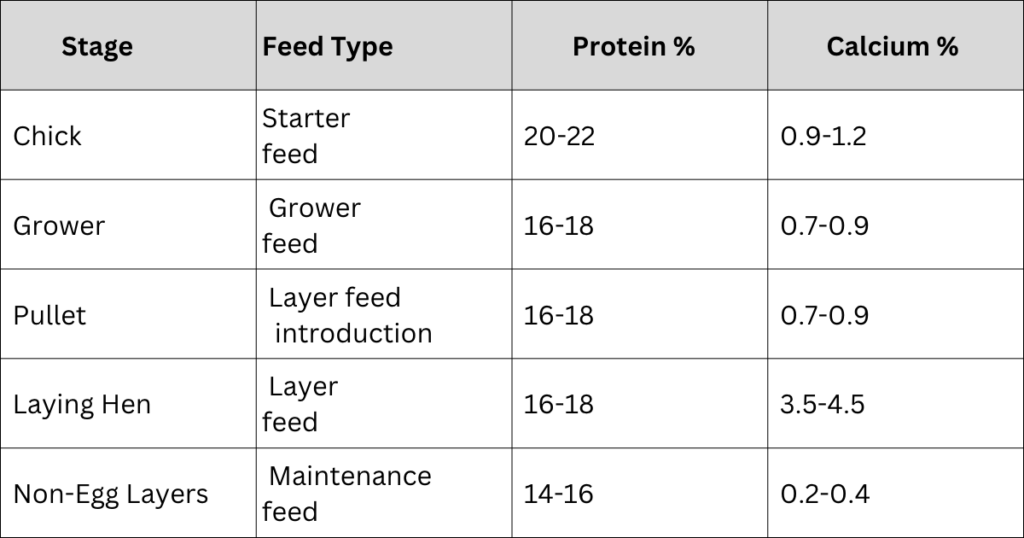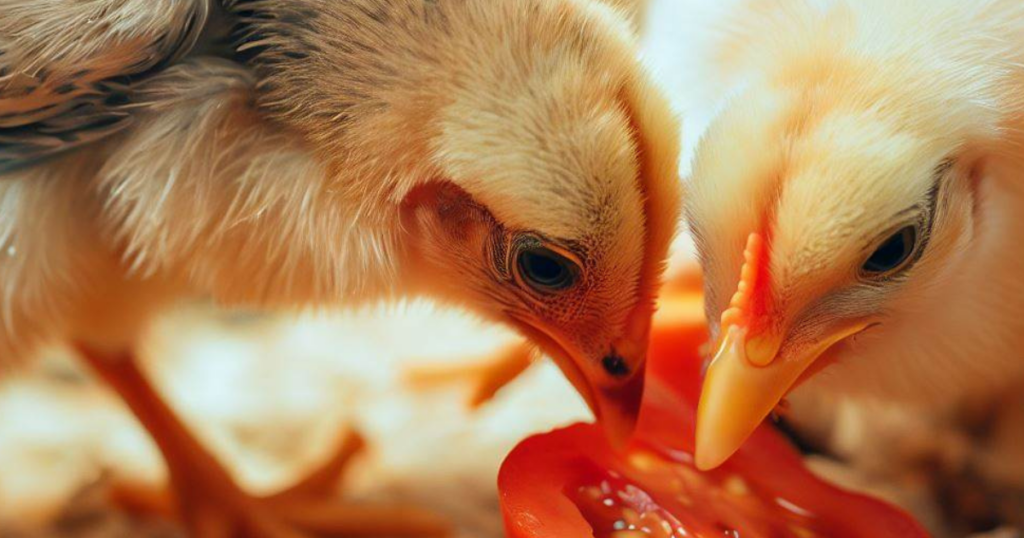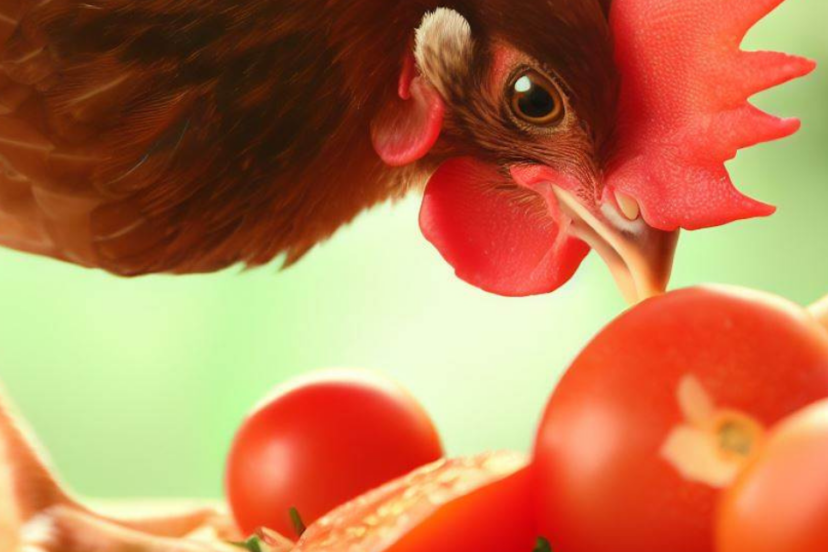Can Chickens Eat Tomatoes? Discover the Truth
Are tomatoes necessary to feed chickens
It’s important for us to understand the dietary needs of our feathered friends. Feeding chickens a balanced and nutritious diet is crucial for their health and well-being. One common question that arises is whether chickens can eat tomatoes. In this article, we will explore the topic of feeding tomatoes to chickens, discussing their nutritional value, potential risks, and how to incorporate them into their diet responsibly.
Feeding chickens with tomatoes is not a necessary part of their diet. Chickens are omnivores and can thrive on a balanced diet that includes a commercial feed specifically formulated for their nutritional needs. This feed typically provides all the necessary vitamins, minerals, and protein for optimal health and egg production.
While tomatoes can be offered as an occasional treat, they should not replace the core components of a chicken’s diet. Tomatoes can provide some vitamins, such as vitamin C and vitamin A, but they should be given in moderation and as part of a varied diet. It’s important to remember that chickens require a balanced combination of grains, protein, vitamins, and minerals to maintain good health.
If you choose to feed tomatoes to your chickens, it’s recommended to offer them in small, chopped pieces. Ensure that the tomatoes are ripe, as unripe or green tomatoes may contain higher levels of toxins. Additionally, always monitor your chickens’ response to any new food to ensure it agrees with them and doesn’t cause digestive issues.
Remember, providing a well-balanced commercial feed is the foundation of a healthy chicken’s diet, and treats like tomatoes should be given sparingly and as supplemental enrichment rather than a primary food source.
Feeding Tomatoes to Chickens
When feeding tomatoes to chickens, it’s essential to prepare them properly. Remove any stems, leaves, and the green parts of the tomato, as they can be toxic to chickens. Cut the tomatoes into small, bite-sized pieces to make them easier for the chickens to consume. It’s also recommended to mash or lightly cook the tomatoes to improve digestibility.
Moderation is key when offering tomatoes to your chickens. Too many tomatoes can lead to digestive upset and diarrhea. Start by offering small amounts and observe how your chickens respond. If they tolerate tomatoes well, you can gradually increase the quantity. Remember, treats should only make up a small percentage of their overall diet.
Benefits of Tomatoes for Chickens
Tomatoes offer several benefits for chickens when fed in moderation. The vitamins, particularly vitamin A, help support eye health and promote good vision. Vitamin C acts as an antioxidant, aiding in the neutralization of harmful free radicals in the body. Additionally, potassium contributes to proper muscle function and electrolyte balance.
Including tomatoes as part of a varied diet can add nutritional diversity and enhance the overall well-being of your chickens. However, it’s important to remember that tomatoes should not replace a balanced feed specifically formulated for chickens.
Risks and Precautions
While tomatoes can be beneficial for chickens, there are some risks and precautions to consider. The green parts of the tomato plant, including the leaves and stems, contain a toxin called solanine, which can be harmful to chickens. Always ensure that you remove these parts before offering tomatoes to your flock.
Additionally, some chickens may have individual sensitivities or allergies to tomatoes. Observe your chickens closely after introducing tomatoes to their diet. If you notice any adverse reactions such as digestive upset or changes in behavior, it’s best to discontinue feeding tomatoes and consult with a veterinarian if necessary.
Other Vegetables for Chickens
While tomatoes can be a healthy treat for chickens, it’s important to offer a variety of vegetables to ensure a well-rounded diet. Some suitable vegetables for chickens include leafy greens like kale and spinach, carrots, cucumbers, zucchini, and bell peppers. Remember to introduce new foods gradually and in small quantities to avoid digestive issues.
Now lets look at what chickens dietary requirements.
Understanding Chickens’ Diet: A Comprehensive Feeding Guide
General Feeding Chart for Chickens
Please note that this chart provides general guidelines. Consult with a poultry nutritionist or veterinarian for specific recommendations based on your flock’s needs.
Feeding chickens a well-balanced diet is essential for their growth, health, and productivity. From their early stages as chicks to adulthood, chickens have specific dietary requirements that need to be met to ensure optimal development. In this section, we will delve into the different stages of a chicken’s life and provide a detailed food chart and feeding guidelines for both egg layers and non-egg layers.

Chick Stage: 0-8 Weeks
During the chick stage, proper nutrition is crucial for healthy growth and the development of strong bones and feathers. Commercially formulated chick starter feed is the best choice for this stage. The starter feed should contain around 20-22% protein to support rapid growth. It should also be nutritionally balanced with essential vitamins and minerals.
Feeding Schedule:
– Provide chick starter feed from day one until around 8 weeks of age.
– Offer feed ad libitum, meaning it should be available to the chicks at all times.
– Ensure a clean and easily accessible water source is provided.
Grower Stage: 8-18 Weeks
Once the chicks reach 8 weeks of age, they transition into the grower stage. During this period, their growth rate slows down, and their nutritional needs change. The grower feed should contain approximately 16-18% protein to support steady growth and development.
Feeding Schedule:
– Continue offering grower feed until around 18 weeks of age.
– Provide feed ad libitum.
– Fresh and clean water should always be available.
Pullet Stage: 18-20 Weeks
At around 18 weeks of age, pullets (young female chickens) are approaching the point of lay. During this stage, their nutritional requirements shift to support the production of eggs. Transitioning to a layer feed is crucial to provide the necessary nutrients for egg development.
Feeding Schedule:
– Start introducing layer feed gradually from 18 weeks onwards.
– Layer feed should contain around 16-18% protein and higher levels of calcium for eggshell formation.
– Continue providing fresh water at all times.
Laying Hen Stage: 20 Weeks and Beyond
Once the pullets start laying eggs, they are considered laying hens. Their nutritional needs focus on supporting egg production, maintaining strong shells, and overall health. Layer feed is specifically formulated to meet these requirements.
Feeding Schedule:
– Offer layer feed to laying hens throughout their laying cycle.
– Layer feed should contain 16-18% protein, increased calcium for shell formation, and essential vitamins and minerals.
– Provide fresh water daily and consider adding oyster shell or crushed eggshells as a calcium supplement.
Non-Egg Layers (Roosters or Non-Laying Hens)
For roosters and non-laying hens, their nutritional needs differ from those of laying hens. They require a maintenance feed that provides balanced nutrition without the high levels of calcium needed for egg production.
Feeding Schedule:
– Offer maintenance feed specifically designed for non-laying chickens.
– Maintenance feed should have a protein content of around 14-16%.
– Provide fresh water daily and ensure access to appropriate grit for digestion.
Incorporating Tomatoes into a Chicken’s Diet
Now that we have covered the different stages of a chicken’s life and their dietary requirements, let’s explore how tomatoes can play a role in their diet. Tomatoes can be a healthy addition when given in moderation as a treat.
- Tomatoes offer vitamins A, C, and K, as well as potassium and antioxidants.
- Introduce tomatoes gradually to prevent digestive issues.
- Remove any toxic parts, such as stems and leaves, before feeding.
- Cut tomatoes into small, bite-sized pieces for easier consumption.
- Start with small quantities and observe the chickens’ response.
- If tolerated well, you can gradually increase the amount of tomatoes offered.
Remember, treats should only make up a small percentage of their overall diet.
What happens if chickens eat tomato leaves
If chickens eat tomato leaves, it can have adverse effects on their health. Tomato leaves, along with the stems and green parts of the plant, contain a toxic compound called solanine. Solanine is naturally occurring in nightshade plants like tomatoes and can be harmful to chickens when ingested in large quantities.
Consuming tomato leaves can lead to digestive upset, such as vomiting or diarrhea, in chickens. In severe cases, it may cause more serious symptoms like difficulty breathing, weakness, or even paralysis. The severity of the reaction depends on the amount of tomato leaves consumed and the size and health of the chicken.
To ensure the safety of your chickens, it is essential to keep them away from tomato plants and any other toxic plants. If you suspect that your chickens have eaten tomato leaves or are exhibiting any unusual symptoms, it is best to consult a veterinarian for proper guidance and treatment.
If chickens eat tomato leaves, it can have adverse effects on their health. Tomato leaves, along with the stems and green parts of the plant, contain a toxic compound called solanine. Solanine is naturally occurring in nightshade plants like tomatoes and can be harmful to chickens when ingested in large quantities.
Consuming tomato leaves can lead to digestive upset, such as vomiting or diarrhea, in chickens. In severe cases, it may cause more serious symptoms like difficulty breathing, weakness, or even paralysis. The severity of the reaction depends on the amount of tomato leaves consumed and the size and health of the chicken.
To ensure the safety of your chickens, it is essential to keep them away from tomato plants and any other toxic plants. If you suspect that your chickens have eaten tomato leaves or are exhibiting any unusual symptoms, it is best to consult a veterinarian for proper guidance and treatment.
Can baby chickens eat tomatoes

Baby chickens, also known as chicks, should not be fed tomatoes. While tomatoes are generally safe for adult chickens in moderation, it is recommended to avoid feeding them to young chicks.
At a young age, chicks have delicate digestive systems that are still developing. Their primary diet should consist of a high-quality chick starter feed that provides them with the necessary nutrients for healthy growth. This specially formulated feed is designed to meet their specific dietary requirements and support their development.
Introducing tomatoes or other foods too early can disrupt their balanced diet and potentially cause digestive issues. It’s important to provide chicks with a proper and well-balanced diet to ensure their optimal health and growth.
Chicks can start eating tomatoes when they are around 8 to 12 weeks old, depending on their development and overall health. At this age, they have typically transitioned from chick feed to a grower feed or a complete layer feed.
As chicks grow into pullets and eventually mature into adult chickens, you can gradually introduce a varied diet that includes fruits and vegetables. However, it is essential to offer these foods in moderation and observe how your chickens respond to them. If you decide to introduce tomatoes to their diet, it’s advisable to offer them in small, chopped pieces to prevent choking hazards and monitor their reaction for any adverse effects.
Closing remarks
Providing the appropriate diet for chickens at each stage of their life is crucial for their growth, health, and productivity. Following a well-structured feeding plan and offering a balanced diet, including the correct feed types and incorporating treats like tomatoes in moderation, will ensure that your chickens thrive. Remember to observe your flock closely and make adjustments as needed to meet their individual needs. With proper nutrition, your chickens will be happy, healthy, and productive members of your flock.
FAQs
1. Can chickens eat green tomatoes?
2. How often should I feed tomatoes to my chickens?
3. Can tomato leaves be fed to chickens?
4. Will feeding tomatoes to chickens change the color of their eggs?
5. Are all parts of the tomato plant toxic to chickens?
*We may earn a commission from purchases made through our links, at no cost to you. This does not affect our product recommendations. Please see our disclosure to learn more.




